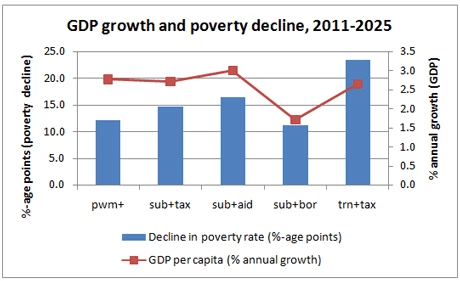The current US drought and its emerging effects on food markets underscore the timeliness and importance of this year’s Global Monitoring Report (GMR), which focused on international food prices, nutrition, and MDGs. One key message of the report, which should be taken on board when the emerging crisis is assessed, is that the effects of changes in international food prices depend on the time frame and on country characteristics, most importantly on shares of domestic supply that are exported or imported and the related issue of the extent to which domestic and international markets are linked. While it is possible for governments to mitigate the effects of international price changes, this can be quite costly, requiring higher taxes, more borrowing, or less spending in other areas, giving rise to difficult trade-offs between various competing development objectives. However, for most countries, given that food trade represents a small share of food supplies and demands, domestic conditions determine to a large extent whether sufficient food is available at prices that are affordable also for the less fortunate – it depends on household incomes and the ability of the agricultural sector to ramp up production. It is important not to exaggerate the role of international markets, especially beyond the short run, when farmers have had the opportunity to respond to international price developments.
These messages emerge from a background paper, prepared for the GMR and highlighted on pp. 81-85 in the full report. The paper* is based on simulations for two archetype or typical low-income countries, representing a net food exporter and a net food importer, using Maquette for MDG Simulations (MAMS), a Computable General Equilibrium model developed by the World Bank’s Prospects Group. The simulations, which cover the period 2011–2025, indicate that the impact of international food price changes on macro and MDG indicators tend to be moderate but leave countries that are heavily involved in international food trade more exposed. A country is in a better position to benefit from or avoid being hurt by price changes the more flexible its economy: Are farmers and other producers able to respond to higher prices by producing more and switching sales between domestic and foreign markets? Can demand be met by domestic substitutes when international prices increase?
For food net importers, which are hurt whenever international food prices increase, the paper looks at two responses, food subsidies and transfers under different financing mechanisms. An untargeted food subsidy, financed by taxes (sub+tax), reduces undernourishment at the cost of a slight deterioration for other indicators. By contrast, if financed by aid (sub+aid), food subsidies neutralize the negative impact of higher import prices whereas financing via domestic borrowing (sub+bor) is both costly and counterproductive, leading to a deterioration across all indicators. If administered at moderate costs, tax-financed targeted transfers (trn+tax) more effectively reduce headcount poverty and inequality with macroeconomic repercussions, including growth in GDP and domestic final demands, that are similar to those of tax-financed subsidies. The figure below shows simulated results for GDP growth and poverty reduction, comparing the scenario with higher import prices without a policy response (pwm+) to scenarios that also include responses. For GDP growth, except for a strong loss for sub+bor, the scenarios are quite similar, with the best performance for sub+aid. In terms of poverty reduction (from a rate of 48% in 2011), trn+tax dominates, followed by sub+aid with the worst outcome for sub+bor. In sum, the analysis of this paper shows that trade structure and flexibility matters, policies can mitigate the impact of price shocks but it matters greatly how they are financed. If the government can manage targeted transfer at a moderate cost, then such a scheme promises to be most effective in reducing poverty.
*Reference: Lofgren, Hans. 2012. World Food Prices and Human Development Policy Simulations for Archetype Low-Income Countries.” World Bank Policy Research Working Paper WPS6033, April.



Join the Conversation